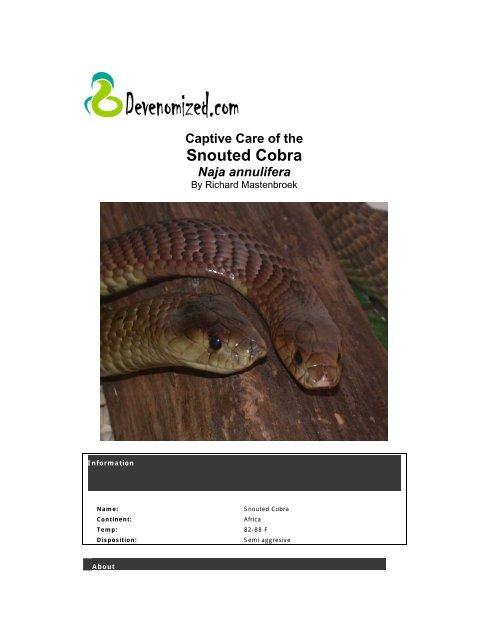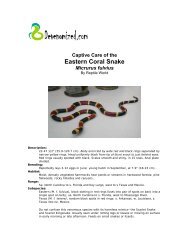Captive Care of the Snouted Cobra Naja annulifera
Captive Care of the Snouted Cobra Naja annulifera
Captive Care of the Snouted Cobra Naja annulifera
You also want an ePaper? Increase the reach of your titles
YUMPU automatically turns print PDFs into web optimized ePapers that Google loves.
Information<br />
<strong>Captive</strong> <strong>Care</strong> <strong>of</strong> <strong>the</strong><br />
<strong>Snouted</strong> <strong>Cobra</strong><br />
<strong>Naja</strong> <strong>annulifera</strong><br />
By Richard Mastenbroek<br />
Name: <strong>Snouted</strong> <strong>Cobra</strong><br />
Continent: Africa<br />
Temp: 82-88 F<br />
Disposition: Semi aggresive<br />
About
The normal snouted cobra (<strong>Naja</strong> <strong>annulifera</strong> <strong>annulifera</strong>) is one <strong>of</strong> <strong>the</strong> most kept<br />
African cobra species, even when many snake keepers think that <strong>the</strong>y keep <strong>the</strong><br />
Egyptian <strong>Cobra</strong> (<strong>Naja</strong> haje haje) is it most <strong>of</strong> <strong>the</strong> time <strong>the</strong> <strong>Snouted</strong> <strong>Cobra</strong>.<br />
Length:<br />
<strong>Naja</strong> <strong>annulifera</strong> <strong>annulifera</strong>; The average adult size <strong>of</strong> this cobra is 150 – 220<br />
cm, maximum 250 cm, males are usually bigger than females.<br />
<strong>Naja</strong> <strong>annulifera</strong> anchietae; The average adult size <strong>of</strong> this cobra is 130 – 190<br />
cm, maximum 230 cm, males are usually bigger than females.<br />
Zoological Description:<br />
<strong>Naja</strong> <strong>annulifera</strong> <strong>annulifera</strong>; The head is large and depressed and slightly<br />
distinct from <strong>the</strong> neck. The neck from <strong>the</strong> <strong>Snouted</strong> cobra is dilatable like all o<strong>the</strong>r<br />
species <strong>of</strong> <strong>the</strong> <strong>Naja</strong> complex. The dilatable neck or also called hood can be 12 -16 cm<br />
wide. The snout <strong>of</strong> <strong>the</strong> <strong>Snouted</strong> cobra is just like <strong>the</strong> head moderately broad, but<br />
pointed. The eyes are quit big with a round pupil. The body <strong>of</strong> <strong>the</strong> <strong>Snouted</strong> cobra is<br />
cylindrical and stout with a long tail.<br />
In color are <strong>the</strong>se cobras been found in many different varieties. Juveniles have a<br />
yellowish or greenish color, <strong>the</strong> scale <strong>of</strong>ten show a dark edging which looks like a<br />
speckled patron, in <strong>the</strong> neck do <strong>the</strong>y have a broad dark band, <strong>the</strong> ventral side is<br />
usually yellow from color. Adults are mostly grey, brown, reddish-brown or black<br />
from color, but we also know a banded color phase which usually caries 6 – 9 bands<br />
on <strong>the</strong> body and 2 – 3 on <strong>the</strong> tail, <strong>the</strong>se snakes have broad black and white cross<br />
bands around <strong>the</strong> body. The ventral side can be yellow or grey from color and can<br />
have speckles or a mottled patron. On <strong>the</strong> throat <strong>the</strong>y have a broad dark band.<br />
. <strong>Naja</strong> <strong>annulifera</strong> anchietae; This subspecies is in morphology similar to <strong>Naja</strong><br />
<strong>annulifera</strong> <strong>annulifera</strong>. The head is large and depressed and slightly distinct from <strong>the</strong><br />
neck. The neck from <strong>the</strong> <strong>Snouted</strong> cobra is dilatable like all o<strong>the</strong>r species <strong>of</strong> <strong>the</strong> <strong>Naja</strong><br />
complex. The dilatable neck or also called hood can be 12 -16 cm wide. The snout <strong>of</strong><br />
<strong>the</strong> <strong>Snouted</strong> cobra is just like <strong>the</strong> head moderately broad, but pointed. The eyes are<br />
quit big with a round pupil. The body <strong>of</strong> <strong>the</strong> <strong>Snouted</strong> cobra is cylindrical and stout<br />
with a long tail. In color is this subspecies <strong>of</strong> <strong>the</strong> <strong>Snouted</strong> <strong>Cobra</strong> quite similar to <strong>the</strong><br />
<strong>Naja</strong> <strong>annulifera</strong> <strong>annulifera</strong> except that this subspecies can also been found in light<br />
yellow and orange. They never seem to become black.<br />
Scalation <strong>Naja</strong> <strong>annulifera</strong> <strong>annulifera</strong>:<br />
- Dorsal scales on <strong>the</strong> midbody 19 (21)<br />
- Ventral scales 175 - 203
- Sub caudal scale is Paired<br />
- Sub caudal scales 51 - 65<br />
- Anal plate is Single<br />
- Upper labials 7 (8)<br />
- Upper labials to <strong>the</strong> eye 0<br />
- Preoculairs 1 (2)<br />
- Postoculairs 2 (1 or 3)<br />
- Lower labials 8 or 9 (10)<br />
- Temporal 1+2, 1+3 Variable<br />
Scalation <strong>Naja</strong> <strong>annulifera</strong> anchietae:<br />
- Dorsal scales on <strong>the</strong> midbody 17<br />
- Ventral scales 179 - 200<br />
- Sub caudal scale is Paired<br />
- Sub caudal scales 51 - 56<br />
- Anal plate is Single<br />
- Upper labials 7 (8)<br />
- Upper labials to <strong>the</strong> eye 0<br />
- Preoculairs 1<br />
- Postoculairs 2<br />
- Lower labials 8 or 9 (10)<br />
- Temporal 1+2, 1+3 Variable<br />
Geographic Range <strong>Naja</strong> <strong>annulifera</strong> <strong>annulifera</strong>:<br />
Sou<strong>the</strong>rn Zambia , Malawi , KwaZulu Natal , Mozambique , Swaziland ,<br />
Zimbabwe , Nor<strong>the</strong>rn provinces <strong>of</strong> South Africa and Botswana land.
Geographic Range <strong>Naja</strong> <strong>annulifera</strong> anchietae:<br />
Northwestern Zimbabwe , Western Zambia , Nor<strong>the</strong>rn Botswana land,<br />
Sou<strong>the</strong>rn Angola , Sou<strong>the</strong>rn Zaire , and Namibia .<br />
Habitat:<br />
<strong>Snouted</strong> cobra inhabiting savanna grasslands, semi desserts, rocky areas<br />
but is also <strong>of</strong>ten found nearby humans in gardens and under houses. They will enter<br />
poultry runs. <strong>Snouted</strong> cobras will <strong>of</strong>ten occupy a permanent home in termite<br />
mounds, holes in rocks, hollow trees, and under dense vegetation. <strong>Snouted</strong> cobras<br />
are nocturnal but can be found basking on a rock close to <strong>the</strong>re residence in <strong>the</strong><br />
early morning. The snouted cobra is not a aggressive species but when cornered it<br />
will stand his ground by spreading his hood, while hissing load, when fur<strong>the</strong>r<br />
provoked it will strike fast.<br />
Behaviour in Captivity:<br />
<strong>Snouted</strong> cobras can be very pleasant animals in captivity. They <strong>of</strong>ten calm<br />
down fairly easy but some will stay easy to irritate. When housed in a large<br />
enclosure will <strong>the</strong>y show a nice active behaviour. <strong>Snouted</strong> cobras that are housed to<br />
small will rub <strong>the</strong>re noses continuously in <strong>the</strong> corners <strong>of</strong> <strong>the</strong>re enclosure which will<br />
damage <strong>the</strong>re rostral scale. Even when <strong>the</strong>y are nocturnal will <strong>the</strong>y show <strong>the</strong>re self<br />
in daytime basking under a spot. <strong>Snouted</strong> cobras are curious animals that spend<br />
many hours <strong>of</strong> investigate <strong>the</strong>re enclosure and with digging in <strong>the</strong> substrate. When<br />
coming close to <strong>the</strong>re enclosure will <strong>the</strong>y watch carefully any movement. <strong>Snouted</strong><br />
cobras can be best handled on <strong>the</strong> tailing method while supporting <strong>the</strong>re body on a<br />
snakehook.<br />
Feeding:<br />
In nature feeds <strong>the</strong> <strong>Snouted</strong> cobra mainly on toads, but <strong>the</strong>y will also eat<br />
small mammals, birds <strong>the</strong>ir eggs, reptiles including o<strong>the</strong>r snakes. Some wild caught<br />
specimens even ate puff adders (Bitis arietans), <strong>the</strong>y will <strong>of</strong>ten enter gardens to<br />
search for food in chicken runs and under trash piles. My snouted cobras are fed with<br />
dead and live rodents and chicks. Dead prey items will be <strong>of</strong>fered out <strong>of</strong> a long<br />
tweezer and will be taken slowly. When fed alive <strong>the</strong>y will hunt <strong>the</strong>re prey down and<br />
will bite <strong>the</strong>m several times. I only feed my snakes live food in a bin.<br />
Breeding <strong>Snouted</strong> <strong>Cobra</strong>s:<br />
<strong>Snouted</strong> <strong>Cobra</strong>s are Oviparous and laying 8 – 34 eggs.The eggs measure a<br />
size <strong>of</strong> 46 – 55 mm X 24 – 32 mm). <strong>Snouted</strong> <strong>Cobra</strong>s are easy to breed cobras when<br />
provided a large and wel setup enclosure. The animals in my collection mate in late<br />
spring or early summer (May, June) after a gestation period <strong>of</strong> 2 months do <strong>the</strong><br />
females lay <strong>the</strong>re eggs in special laying boxes placed in <strong>the</strong> enclosure. Mating can<br />
take a few minutes to several hours. I don’t give my <strong>Snouted</strong> <strong>Cobra</strong>s a hibernation<br />
period, but in winter time will <strong>the</strong> average room temperature drop some degrees and<br />
<strong>the</strong> animals will not get as much food as in <strong>the</strong> warmer months. The eggs are placed<br />
in a dry incubator on sterilized sand. The temperature in <strong>the</strong> incubator varies<br />
between 27 - 30 0 C with a humidity level around 80% which can be adjust by<br />
spraying water. After about 65 – 90 days <strong>the</strong> eggs will hatch, hatchlings measure a
size <strong>of</strong> 22 – 35 cm in length. The hatchlings will shed for <strong>the</strong> first time after 8 – 12<br />
days. After <strong>the</strong>re first shedding food will be <strong>of</strong>fered. I feed my juvenile <strong>Snouted</strong><br />
<strong>Cobra</strong>s with baby mice, which most <strong>of</strong> <strong>the</strong>m will accept <strong>the</strong> first time, hatchlings that<br />
not eat will be force fed till <strong>the</strong>y start eating on <strong>the</strong>re own. The hatchlings are kept<br />
separate in plastic boxes till <strong>the</strong>y reach a size <strong>of</strong> around 70 cm.<br />
The enclosure:<br />
I currently keep two breeding pairs <strong>of</strong> <strong>Snouted</strong> cobras. The biggest pair is<br />
housed in a enclosure <strong>of</strong> 200 x 50 x 60 cm (length x wide x height), <strong>the</strong> o<strong>the</strong>r pair is<br />
housed in a smaller enclosure that measures a size <strong>of</strong> 150 x 50 x 50 cm (length x<br />
wide x height). Both enclosures are heated by floor heating and a basking spot <strong>the</strong><br />
average temperature in <strong>the</strong> enclosures is 25 - 28 0 C and directly under <strong>the</strong> spotlight<br />
34 - 38 0 C in daytime. At night <strong>the</strong> temperature will drop a few degrees Celsius. The<br />
humidity is around 60%.<br />
As substrate I use a mixture <strong>of</strong> river sand and peat. As decoration I use Elephant<br />
trunk trees, rocks and some plastic plants. In both enclosures is a big 5 litre water<br />
bowl that is surprisingly used quit <strong>of</strong>ten for batting. The enclosures are build from<br />
chip-wood and can be opened by 6 mm glass sliding doors that can be locked with a<br />
glass showcase lock. On <strong>the</strong> cold site <strong>of</strong> <strong>the</strong> enclosure is a hide box placed where <strong>the</strong><br />
snakes live in daytime when not basking under <strong>the</strong> spotlight.



